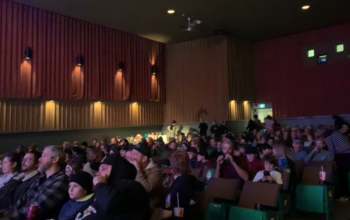
This summer’s drought gave the city of Kamloops an opportunity for introspection regarding its water usage, as its Provincial drought rating reached level five, among many other cities.
According to the Government of B.C.’s website, in a drought level five, “Adverse impacts to socio-economic or ecosystem values are almost certain.” Deven Matkowski, City of Kamloops engineering manager, reveals that Kamloops’ restrictions are off, though the city has only moved down to level four.
In British Columbia, seasonal droughts in recent years have resulted in increasing water stress, worsened by climate change. Projections for rising temperatures in mid-century over B.C. is “+1.0 to +3.8°C for the summer season and +1.1 to +3.9°C for the winter season.”
Kamloops is situated, fortunately, with a huge watershed from the Thompson Rivers. However, the water level of the river had been low throughout the summer months. Matkowski thinks changes in water level are dependent on the last few seasons of weather, with a worsening trend.
“We are seeing historically lower river levels, that we’re definitely at a point in the cycle, if it is a cycle, or from impacts of climate change, where the river levels are definitely low.”
Water levels are something Matkowski says they are actively studying. “One of the things we’re definitely seeing in our watershed is some of these low levels during the summertime. We’re expecting also to see changes in what the high levels are in the springtime.”
Water supply lowering could pose a significant challenge due to all the elements of the city’s distribution system that pumps water throughout three valleys, as City of Kamloops utilities manager Greg Wightman suggests. “We have the most number of pump stations and reservoirs, all the elements of our distribution system that we’re required makes us the most complex in Canada.”
Wightman reveals that Kamloops has one of the highest peaking factors in the country, spiking to high usage in the summer compared to winter. “What drives that is irrigation, both residential, commercial, and in our playing fields, school district fields, things like that.” He states that the large amount of irrigation systems is due to tournament capital initiatives by the City of Kamloops.
Residents are lucky to be provided with potable water, for a multitude of uses, from Kamloops Centre for Water Quality. With long-term water conservation, the water distribution system can run more efficiently.
“The less we pump, the less we pay for electricity to pump, the less the infrastructure wears out that we have to replace infrastructure,” says Matkowski.

Drought Response and Log-Term Water Conservation
Observable changes in water levels locally will likely generate more of a community response than facts about lower watershed areas.
There’s a difference between drought response and long-term water conservation. “Long-term water conservation is key”, says Matkowski, defining this as “being efficient with the resource, not being wasteful.”
“It’s interesting how well the community has been at responding to requests from the city so not just this year with drought but previous years,” says Matkowski. “Society has changed as well, which is helpful. I think people are a lot more aware now of what they’re using water for and not wasting it.”
With visual dangers presenting themselves in the community, such as smoky skies from nearby fires, Kamloops residents sprung to action during the summer. “We used to be like eight to ten times in the summer, what we would use in the winter. Now we’re down to five times,” says Matkowski.
Fear and proximity do generate a greater response to calls for action, which doesn’t translate well to long-term water conservation as much as it helps with an emergency drought response.
“If you talk to people in January about trying to conserve water by taking a shorter shower, I don’t know you’re gonna get that same response,” suggests Wightman.
Opportunity for Re-Education
This summer’s high drought rating, as well as the implementation of water meters, spurred the community into action.
“So we saw this massive reduction, it was an incredible response by the community,” says Wightman. “And it did exactly what we needed to do for the environment.”
Matkowski believes people in Kamloops are already fairly efficient with indoor usage, due to multiple educational initiatives, not just from the city of Kamloops.
The reduction was therefore representative of restrictions on outdoor water use that residents managed to follow.
Matkowski sees this as an opportunity for us to do better. “So that’s something that’s probably more coming out as education campaigns, a little bit more awareness, specifically focused around the outdoor water use.”
“This whole drought response and seeing how people can manage with their irrigation systems turned completely off, I think, is a good opportunity for re -education and re -awareness.”
The City of Kamloops has tips on their website that will help Kamloops continue to reduce their outdoor water usage, such as ensuring sprinklers are watering lawns only, checking for leaks, not leaving hoses or sprinklers unattended, and keeping in mind “Lawns only need about 2.5 cm (1 in.) of water per week.”

